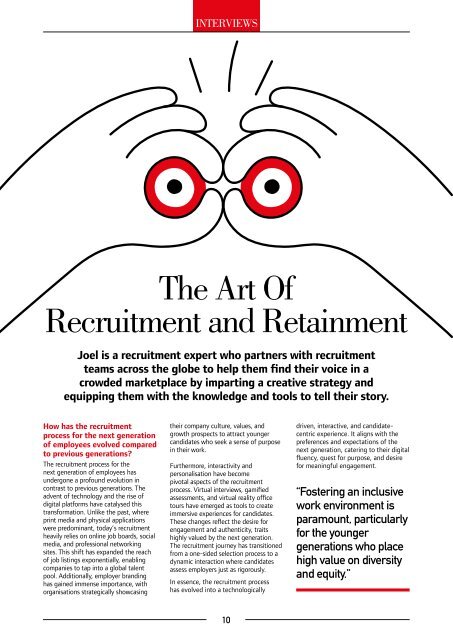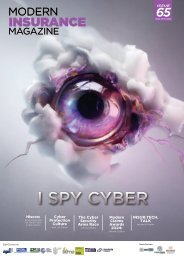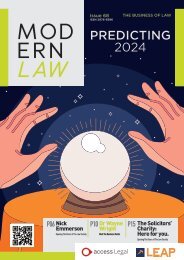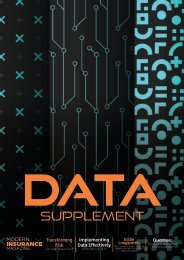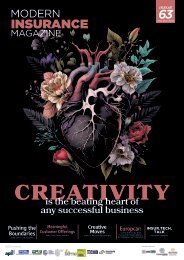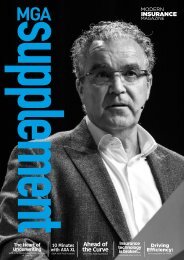Modern Law Magazine Issue 66
Create successful ePaper yourself
Turn your PDF publications into a flip-book with our unique Google optimized e-Paper software.
INTERVIEWS<br />
INTERVIEWS<br />
“Effective attraction and retention involve transparent communication,<br />
flexible work arrangements, investment in growth, interactive recruitment,<br />
recognition, and an inclusive culture.”<br />
The Art Of<br />
Recruitment and Retainment<br />
Joel is a recruitment expert who partners with recruitment<br />
teams across the globe to help them find their voice in a<br />
crowded marketplace by imparting a creative strategy and<br />
equipping them with the knowledge and tools to tell their story.<br />
How has the recruitment<br />
process for the next generation<br />
of employees evolved compared<br />
to previous generations?<br />
The recruitment process for the<br />
next generation of employees has<br />
undergone a profound evolution in<br />
contrast to previous generations. The<br />
advent of technology and the rise of<br />
digital platforms have catalysed this<br />
transformation. Unlike the past, where<br />
print media and physical applications<br />
were predominant, today’s recruitment<br />
heavily relies on online job boards, social<br />
media, and professional networking<br />
sites. This shift has expanded the reach<br />
of job listings exponentially, enabling<br />
companies to tap into a global talent<br />
pool. Additionally, employer branding<br />
has gained immense importance, with<br />
organisations strategically showcasing<br />
their company culture, values, and<br />
growth prospects to attract younger<br />
candidates who seek a sense of purpose<br />
in their work.<br />
Furthermore, interactivity and<br />
personalisation have become<br />
pivotal aspects of the recruitment<br />
process. Virtual interviews, gamified<br />
assessments, and virtual reality office<br />
tours have emerged as tools to create<br />
immersive experiences for candidates.<br />
These changes reflect the desire for<br />
engagement and authenticity, traits<br />
highly valued by the next generation.<br />
The recruitment journey has transitioned<br />
from a one-sided selection process to a<br />
dynamic interaction where candidates<br />
assess employers just as rigorously.<br />
In essence, the recruitment process<br />
has evolved into a technologically<br />
driven, interactive, and candidatecentric<br />
experience. It aligns with the<br />
preferences and expectations of the<br />
next generation, catering to their digital<br />
fluency, quest for purpose, and desire<br />
for meaningful engagement.<br />
“Fostering an inclusive<br />
work environment is<br />
paramount, particularly<br />
for the younger<br />
generations who place<br />
high value on diversity<br />
and equity.”<br />
What are the key characteristics and skills that<br />
the next generation of job seekers bring to the<br />
workforce?<br />
The next generation of job seekers, primarily consisting<br />
of Millennials and Generation Z, bring a distinct set of<br />
characteristics and skills to the workforce. Technologically adept,<br />
they possess exceptional digital literacy and communication<br />
skills, seamlessly navigating digital platforms and adopting new<br />
technologies. Their adaptability is a hallmark trait, enabling<br />
them to quickly learn and integrate evolving tools and software<br />
in the ever-changing workplace.<br />
A central characteristic is their strong emphasis on purpose-driven<br />
work. These job seekers seek roles that align with their values and<br />
contribute to societal betterment, valuing meaningful impact over<br />
job titles. Collaboration and teamwork come naturally to them, as<br />
they thrive in diverse and inclusive work environments. Effective<br />
collaborators, they excel in cross-functional projects, drawing on their<br />
open-mindedness and adeptness in harnessing collective strengths.<br />
Furthermore, critical thinking and creativity characterise their<br />
problem-solving approach. They possess the capacity to analyse<br />
complex situations, offering innovative solutions that reflect their<br />
ability to think beyond convention. Multitasking is another forte;<br />
they’re accustomed to managing various responsibilities concurrently.<br />
The next generation brings digital prowess, adaptability, purposedriven<br />
perspectives, collaborative skills, critical thinking, and<br />
multitasking abilities to the workforce. These attributes align<br />
with the demands of modern workplaces, fostering innovation,<br />
inclusive collaboration, and a forward-thinking approach.<br />
How can employers effectively attract and retain<br />
the next generation of talent in a competitive<br />
job market?<br />
Effectively attracting and retaining the next generation of talent<br />
in a competitive job market requires a multifaceted approach<br />
that aligns with their values and aspirations. Employers must<br />
prioritise transparent communication of company culture, growth<br />
opportunities, and work-life balance. Clear articulation of the<br />
organization’s mission and impact resonates with their desire for<br />
purposeful work.<br />
Flexible work arrangements, including remote options and<br />
adaptable schedules, acknowledge their pursuit of work-life<br />
integration. Investment in professional development programs<br />
and mentorship opportunities demonstrates commitment to their<br />
growth. Offering personalised career paths showcases long-term<br />
prospects within the organisation.<br />
Interactive recruitment processes, such as virtual office tours<br />
and gamified assessments, engage their tech-savvy nature.<br />
Consistent feedback loops and open channels of communication<br />
demonstrate their voices are heard.<br />
To retain this talent, fostering an inclusive and collaborative<br />
workplace culture is vital. Recognising their contributions and<br />
creating platforms for their ideas to flourish fosters a sense of<br />
belonging. Regular feedback sessions align with their desire for<br />
growth and learning.<br />
Effective attraction and retention involve transparent<br />
communication, flexible work arrangements, investment in<br />
growth, interactive recruitment, recognition, and an inclusive<br />
culture. Employers who align with these values will stand out in<br />
the competitive job market and cultivate a loyal and motivated<br />
next-generation workforce.<br />
Are there any specific generational preferences<br />
or expectations that employers should be aware<br />
of when designing their recruitment strategies?<br />
Employers should be acutely aware of generational preferences<br />
and expectations when designing recruitment strategies, as<br />
tailoring approaches to resonate with each generation is crucial.<br />
For instance, Millennials and Generation Z prioritise authenticity<br />
and transparency. They seek organisations that align with their<br />
values and are more likely to engage when companies showcase<br />
their ethical practices and societal contributions.<br />
Work-life balance is a recurring theme, especially for Millennials<br />
and Gen Z, who prioritize flexibility and remote work options.<br />
Highlighting these arrangements can greatly influence their<br />
decision to join an organization.<br />
Moreover, fostering an inclusive<br />
work environment is<br />
paramount, particularly for<br />
the younger generations<br />
who place high value<br />
on diversity and equity.<br />
Employers should<br />
showcase their commitment<br />
to these principles in their<br />
recruitment materials.<br />
Employers should craft<br />
recruitment strategies that<br />
emphasise authenticity,<br />
interactive experiences,<br />
flexible work options,<br />
inclusivity, and avenues<br />
for growth, reflecting the<br />
preferences and expectations of<br />
each generation.<br />
10<br />
11


